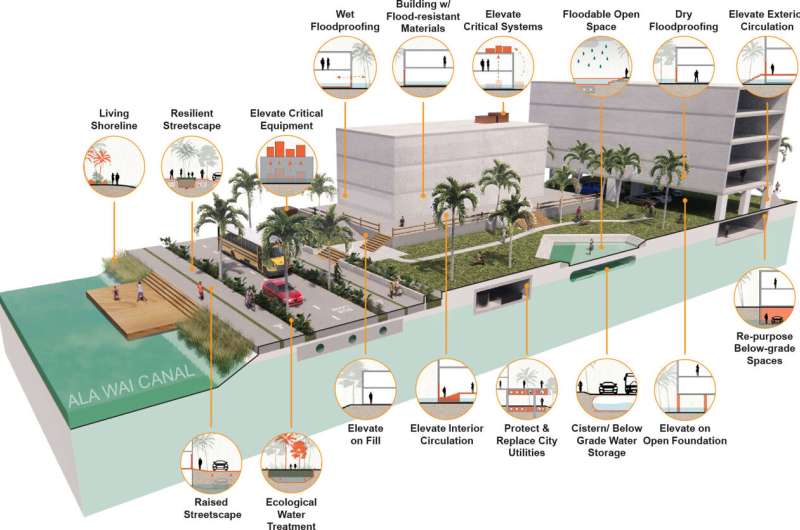This article has been reviewed according to Science X's editorial process and policies. Editors have highlighted the following attributes while ensuring the content's credibility:
fact-checked
peer-reviewed publication
trusted source
proofread
Team presents sea-level rise adaptations to elevate infrastructure and utilities

Sea level in Waikīkī is projected to rise up to about one foot by 2050 and nearly six feet by 2100 due to climate change, prompting University of Hawaiʻi at Mānoa researchers to create architectural renderings that illustrate possible adaptation strategies. The strategies include relocating critical equipment within buildings and streets, elevating utilities and walkways, and incorporating cisterns and bioretention areas to manage stormwater runoff. These strategies can be applied to other low-lying coastal cities.
With potential losses from sea-level rise projected to reach $19 billion in Hawaiʻi alone, protecting Waikīkī, a major economic hub generating $5 billion annually for the state, is crucial. The research by principal investigator and UH Mānoa Associate Professor Wendy Meguro and her team was published in Sustainability in March and a special issue of Oceanography in April.
"We're looking at Waikīkī because it is an economic, recreational, and cultural hub," said Meguro, director of the School of Architecture Environmental Research and Design Laboratory and the Hawaiʻi Sea Grant Center for Smart Building and Community Design. "But the process that we are using to visualize potential adaptation strategies and discuss them with the community should be replicable in other areas. Given the long lifespan of buildings or roadways, they will likely still exist in 50 years. The decisions we make today should anticipate the flooding that we will have 50 years from now."
Public feedback
Public outreach surveys indicated that 79% of participants found the proposed strategies relevant and feasible for Waikīkī. Community involvement in the adaptation planning process was demonstrated through workshops, public presentations and surveys, engaging more than 700 stakeholders in 2021–2023.
"In public outreach events, we presented urban and architectural renderings that depicted a specific site and discussed how we might adapt, for example, by elevating a building," said Meguro. "The renderings have been a key communication tool to initiate a coordinated conversation with many parties. And in our surveys, we've been able to get the public's feedback on those strategies, and have found that people are really interested in elevating critical equipment, both in buildings and at the streetscape."
Role of academia
"The research underscores academia's role in supporting governmental and municipal efforts to address climate change," according to Josephine Briones, a UH Mānoa climate adaptation specialist. By providing visualizations and engagement opportunities, the team has helped bridge the gap between scientific research and practical, community-driven solutions.
"The role of academia is important in addressing future responses to the effects of climate change, particularly sea-level rise in Hawaiʻi," said Briones. "Academic research plays a pivotal role in illustrating potential future adaptation strategies in low-lying coastal communities and enhances local municipalities' adaptation plans."
Looking ahead, the team aims to build on their framework by continuing to integrate academic research, community input and policy planning.
More information: Wendy Meguro et al, A Science and Community-Driven Approach to Illustrating Urban Adaptation to Coastal Flooding to Inform Management Plans, Sustainability (2024). DOI: 10.3390/su16072849
Wendy Meguro et al, A Visionary Approach to Advancing Sea Level Rise Adaptation in an Urban Coastal Community, Waikīkī, Hawai'i, Oceanography (2024). DOI: 10.5670/oceanog.2024.223
Journal information: Oceanography
Provided by University of Hawaii at Manoa





















